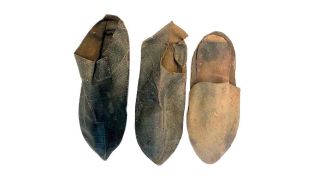Artistic giant Michelangelo was actually quite short
A new analysis of the artist's shoes revealed his small stature.

As an artist, the legendary Michelangelo Buonarroti left behind some big shoes to fill. But in real life, the great painter's shoes weren't big at all — and neither was Michelangelo.
Italian researchers recently examined three shoes that were found in Michelangelo's home after his death and are thought to have belonged to the Renaissance artist: a pair of leather shoes and a single leather slipper (the companion was stolen in 1873), in the collection of the Casa Buonarroti Museum in Florence, Italy.
The researchers' analysis is the first to estimate physical characteristics of the artist based on measurements of personal objects such as footwear, and they found that Michelangelo, while still an artistic giant, stood no more than 5 feet 2 inches (1.6 meters) tall.
Related: 11 hidden secrets in famous works of art
While this is relatively short for a European adult man by today's standards, at the time Michelangelo was alive (1475 to 1564) that height would not have been unusual, said scientists with the Forensic Anthropology, Paleopathology and Bioarchaeology Research Center (FAPAB) in Avola, Italy.
FAPAB researchers Francesco Galassi, a paleopathologist, and Elena Varotto, a forensic anthropologist, measured the shoes and then calculated the wearer's foot dimensions and height, and their results aligned with a description of Michelangelo by the 16th-century artist and writer Giorgio Vasari. Vasari wrote that Michelangelo was "broad in the shoulders" but the rest of his body was "somewhat slender in proportion" and his stature was average, according to the study.
The shoes were all similar in size, suggesting that both pairs (when the slipper pair was complete) were worn by the same person. However, even though the shoes have long been attributed to Michelangelo, it's also possible that they belonged to another man in the artist's household, such as a family member or one of Michelangelo's descendants, the scientists wrote.
Sign up for the Live Science daily newsletter now
Get the world’s most fascinating discoveries delivered straight to your inbox.
Michelangelo may have been in poor health toward the end of his life, and likely had gout and lead poisoning as well as severe arthritis in his hands, according to clues found in Michelangelo's own writings and in painted portraits of the artist, Live Science previously reported. As Michelangelo's remains have never been exhumed and analyzed, it's difficult for scientists to be certain about the artist's condition when he died at the age of 88. However, studies such as this can help to fill in some of the physical details about Michelangelo toward the end of his lifetime, the authors reported.
The findings were published in the September 2021 issue of the journal Anthropologie.
Originally published on Live Science.

Mindy Weisberger is an editor at Scholastic and a former Live Science channel editor and senior writer. She has reported on general science, covering climate change, paleontology, biology, and space. Mindy studied film at Columbia University; prior to Live Science she produced, wrote and directed media for the American Museum of Natural History in New York City. Her videos about dinosaurs, astrophysics, biodiversity and evolution appear in museums and science centers worldwide, earning awards such as the CINE Golden Eagle and the Communicator Award of Excellence. Her writing has also appeared in Scientific American, The Washington Post and How It Works Magazine.
